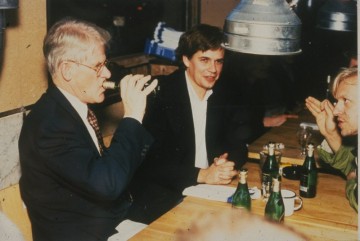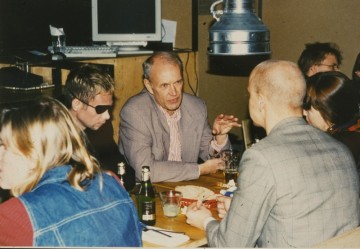
David Hammons. "America The Beautiful," 1968. On view in "Now Dig This! Art and Black Los Angeles, 1960 - 1980," at the Hammer Museum, Los Angeles.
Let’s face it. Occupy Wall Street, and just about everything else, is about money – who has it and who doesn’t – and how the market can help or hurt these two groups.
Money
I recently bought an iPhone. While this may seem trivial, I hadn’t had a cell phone for over 10 years. Although most people consider a cell phone a necessity, I didn’t–although artists without studio buzzers who had to watch for my arrival would probably disagree. In my last post, I mentioned the power of the purse, which is usually considered a way of holding back funding so that the money goes somewhere else. One could say I held back money from Verizon, and since the average cell phone bill is roughly $50 a month, it amounted to $6000 over ten years. In that same post, I proposed that we should buy what we value; so what could I have bought, if art and community are what I value?
Here are some innovative ways in Chicago that community-supported commerce can foster art and the spaces that present and support artists:
1. Threewalls’ community supported art share is patterned after community-supported agriculture (CSA) “shares” or subscriptions, which offer produce in a box (in threewalls’ case, art). Threewalls sells 31 shares for $310.
2. Artist Jennifer Mills’s Dealing With New Demands, part of The Happiness Project, presents original, affordable artworks as a sales event with proceeds going to the artists, curator, and Street-Level Youth Media. The sold work becomes a catalyst for conversation in the collectors’ homes about quality-of-life issues, and the red “sold” dots suggest a booming art economy created by artists.

Jennifer Mills. "Dealing with New Demands," 2011. The artist "performs" as an art dealer and will "sell" the ideas of happiness as well as the works of art themselves, which are about happiness and quality of-life-issues.
3. Hornswaggler Arts sells hand-crafted cocktails at art openings, and with the proceeds, they purchase a work from the show, which then enters their collection and loan program.
4. According to the local Alderman, in one night Kegs for Kids raised enough money last year to hire a public school art teacher and expand the school’s art programming.
These are small-scale, local initiatives where my $6000 would go far. (If you have additional community-supported commerce ideas that foster art, please share them with others so that they, too, can grow). On a larger scale, in Chicago’s 49th ward this year Alderman Joe Moore began the first US participatory budgeting project, originally developed in Porto Alegre, Brazil in 1989, in which citizens identify, discuss, and prioritize public spending projects. Six citizen committees (one of which promoted art) were organized in order to decide which projects should be put on the ballot. Fourteen projects were ultimately selected by 1,600 people to receive $1.3 million in funding for capital infrastructure. In the 48th Ward, which aims to be a new artistic center of Chicago, artist Kirsten Leenaars, in conjunction with The Happiness Project’s Under Construction, is working with local citizens to film how democracy can function, at the same time as 48th ward Alderman Harry Osterman launches a citizen master-planning process for his ward.
Leenaars is from the Netherlands, which has a Central Planning Bureau that scrutinizes the potential economic impact of the programs of the candidates running for election. I write this as President Obama has raised over $85 million for his campaign (this week, Michelle Obama will be in Chicago, where you and up to 5 others can take your picture with her for $10,000 at a fundraiser). Now, if we go back to my idea of buying what I value, what would happen if, instead of spending that $85 million on ads, lobbyists, etc., President Obama went to Occupy Wall Street and sat with the 99% and asked them to figure out how that money should be spent? He could also go to the 1% on Wall Street and ask them the same question. As in Swedish artist Jörgen Svensson’s Government Dinner, 1994, they could eat and drink together and propose plans to decide how to spend the money.
Various studies suggest that participatory budgeting results in a higher quality of life, more equitable public spending, and enables consensus building, efficiency, and inclusiveness in public life. Encouraging participation can also promote both good citizenry and good governance, builds trust by ensuring the accountability of officials and public institutions, reveals needs and values, and addresses problems. To be heard – that is what the 99% and the 1% want. Isn’t that the power of democracy?
Market
My recent visit to Los Angeles to present artist Kim Schoenstadt’s architectural wall installation at the Art Platform fair coincided with Pacific Standard Time: Art in LA: 1945 – 1980, a city-wide celebration of LA’s art history [read additional discussions of PST and its related exhibitions in Art21 Blog’s Looking at Los Angeles column]. Coming from Chicago, which recently lost its “second city” status to LA, it is fascinating to observe the latter city’s historical transformation from having a very limited art market to a now-burgeoning one that includes large gallery districts in Beverly Hills, Culver City, and Venice, among others. Art Platform organized a number of trips to collectors’ homes, where I noticed that, unlike Chicago, Los Angeles collectors proudly collect Los Angeles artists. This is slowly changing in Chicago, with the impressive Chicago art collection that long-time local supporters Jack and Sandra Guthman donated to the Harris Theatre as a great example.
When discussing the art market, it is important to note that the Getty Foundation gave $3.1 million dollars to help fund Pacific Standard Time. The “art market,” then, is more than just galleries: it includes ideas, conversations, voices, foundations, and institutions, along with money. In developing Pacific Standard Time’s initiatives, the Getty Foundation called for research “that investigates movements, artists, and ideas that have yet to receive significant scholarly attention, or those that acknowledge the importance of networks—interpersonal, artistic, institutional—in the development of Southern California’s artistic landscape.” While Pacific Standard Time has been derided for its emphasis on regionalism, I believe it’s a powerful compilation of a history that is still largely unknown to the rest of the country, and hence has remained unwritten. From Edward Keinhholz’s chilling 5 Card Stud installation at LACMA, to the amazing works by David Hammons and a host of other artists at Now Dig This! Art and Black Los Angeles, 1960-1980 at the Hammer Museum, to smaller shows such as Collaboration Labs at 18th Street Arts Center that highlight the rich collaborative and performative histories of LA, Pacific Standard Time represents a re-writing of history. This, too, represents the power of money and the market: to give a platform and a voice to what has been marginalized, so that now that voice can be heard.
How, then, can we use money and the market’s power not only to provide a platform for marginalized voices, but as a way to regain democracy? President Obama using his “war chest” as a way to bring the country together for a “people’s dinner and discussion” could be an important first step. How he then chooses to spend the $85 million would ultimately reveal his values, judgements, and beliefs – more than any advertisement or campaign would – and we would have until election day to judge the results.






Pingback: the happiness project and local politics in ‘under construction’ « Kirsten Leenaars
Pingback: Art 21 blog: Money/Market « Kirsten Leenaars